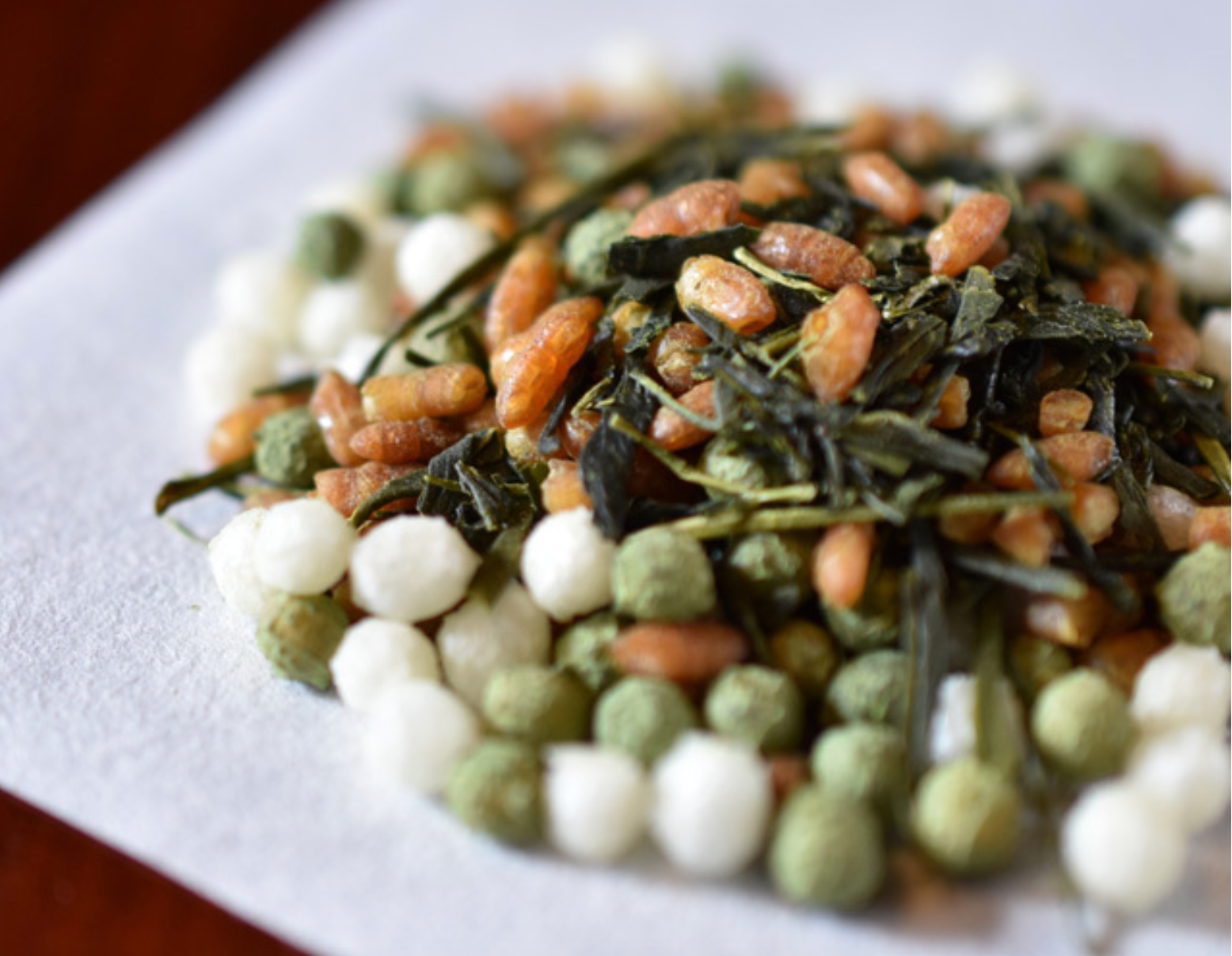すでにご存知の方もいらっしゃるかと思いますが、 11月1日は「玄米茶の日」です。
玄米茶は、煎茶や番茶を焙煎米と混ぜて作る日本茶です。このタイプのお茶を淹れることで、焙煎米の香りが引き立ちます。玄米茶には様々な種類がありますが、焙煎米と番茶を1:1の割合で淹れるのが一般的です。玄米茶は、ポップコーン状の米粒が入っていることから「玄米茶」や「ポップコーン茶」とも呼ばれています。私の義父は「ライスクリスピー茶」と呼んでいますが、皆さんも独自の愛称を持っているかもしれません。
嬉しいことに、玄米茶は手頃な価格であることが多いです。これは、焙煎米に使われるお茶が、高級茶葉(例えば、一番茶)ではなく、ややグレードの低い普段使いの茶葉であることが多いためです。もちろん例外もあり、高級煎茶やかぶせ茶(薄く色をつけたお茶)をベースにした非常に高品質の玄米茶を出す茶店もあります。さらに、玄米を使うので、一般的な煎茶に比べて茶葉の量が少なくなります。つまり、玄米茶のカフェイン含有量はやや低くなります。一般的に、煎茶のカフェイン含有量はコーヒーや紅茶よりも少なく、玄米茶はさらに少ない(ゼロではありませんが!)ので、カフェインに敏感な人にも優しいお茶であり、子供にも飲ませやすいお茶と考えられています。玄米茶の魅力は、煎茶の上品な風味に加え、焙煎米の香ばしさと香ばしさも楽しめることかもしれません。日本では、食後に口の中をリフレッシュしてくれることから、食後茶として人気があります。

Yunomiのサイトでは、玄米茶の種類も豊富に揃っているので、ぜひチェックしてみてください。ほうじ茶を混ぜたもの(左の写真)や、 抹茶をふりかけたものなど、種類も豊富です!
玄米茶の焙煎米について
「玄米」は玄米を指しますが、現在では玄米茶には炒った白米を使うのが一般的です。玄米を使うと、お茶の味よりも米の風味が勝ってしまうことが分かっているからです。お茶を混ぜる際に餅米を使うところもあります。炒った米はどのように作られるのでしょうか?炒った米を作るには、米を一晩水に浸します。そして翌日水を濾し、米をきれいな黄金色になるまで炒ります。炒った米の香りは、基本的に玄米茶を淹れたときに漂う香りです。もし冒険心があれば、炒った米を自分で作って、お気に入りの煎茶や番茶に加えてみるのも良いでしょう。最近では、日本でも炒った米が別売りで販売されているので、これもまた家にあるお茶に混ぜて楽しむことができます。炒った米は、一口サイズの日本のせんべいであるあられのように、そのまま食べても美味しいと言われています。
玄米茶の中には、白くて花のような焙煎米が入っているものがあります。これはポップコーンのように弾ける白い米から作られています。「玄米花」(花は花の意味)と呼ばれ、玄米茶の色を鮮やかにするために使われています。福岡県八女市にある千代乃園の玄米茶には、この花のような形の米粉が入った、 とても素敵な玄米茶があります。

矢部園茶舗の玄米茶は、せんべい入りのユニークな一杯(プレーンと抹茶味)で、見た目も美しく、香ばしいナッツの風味も加わります。お気に入りの玄米茶はありますか?
玄米茶のルーツ
今日、日本人は米を混ぜたお茶を玄米茶と認識しています。しかし、玄米茶の起源を辿ってみると、そうではありません。
昭和初期、京都の茶商が正月の鏡開きで割れた鏡餅を見て、「この餅を少しでも活用できたら…」と思い立ち、その餅を焙ってお茶に混ぜるという発想が生まれたという逸話があります。また、炊飯後に釜に残ったシャキシャキとした米粒をお茶に加えたのが、このお茶の始まりだったという逸話もあります。
玄米茶の起源は謎に包まれていますが、京都には元祖玄米茶を名乗る老舗茶屋がいくつかあり、いずれも大正末期から昭和初期にかけて玄米茶の販売を始めたと言われています。ちなみに、食材を大切に、無駄なく使うという考え方こそが、日本人の心に深く根付いた「もったいない」の精神と言えるでしょう。また、鏡餅には神様が宿ると言われ、古くから健康や繁栄を願う縁起物として親しまれてきました。茶文化の中心地である京都で、この「もったいない」文化と縁起餅がどのように結びついたのか、興味深いところです。
 PhotoAC によると、お正月になると日本全国で鏡餅が見られるようになるそうです。
PhotoAC によると、お正月になると日本全国で鏡餅が見られるようになるそうです。
最後に補足ですが、このお茶の起源について調べていたところ、面白い説、あるいは作り話のような話がいくつか出てきました。その一つは、玄米茶の起源は15世紀の日本にまで遡り、「玄米」という召使いが主君に緑茶を注いでいた時に、誤って袖から玄米を落とし、主君の緑茶のカップの中に入れてしまったというものです。主君は激怒し、召使いの首をはねましたが、お茶を飲み、玄米と緑茶の組み合わせが実に美味しく、しかもバランスが良いことを発見しました。この話に近い別のバージョンでは、侍が召使いの玄米を高く評価していたため、玄米は助命されました。この混ぜ合わせたお茶が飲まれ、召使いの玄米にちなんで「玄米茶」と名付けられたというものです。
玄米茶の起源には、面白い話がたくさんあるようですね!季節的にも、この時期(秋)は稲刈りの時期なので、玄米茶を楽しむのに良い時期です。今日、玄米茶について何か新しいことを学んでいただけたでしょうか?近い将来、玄米茶を一杯楽しんでいただけることを願っています。乾杯!
関連文献:
注目の画像: 宮城県石巻市(お茶の産地最北端!)の茶農家、佐々木さんの煎茶に、炒り米とせんべいをブレンドした「ものうちゃ玄米茶」。 矢部園茶舗で販売中。


